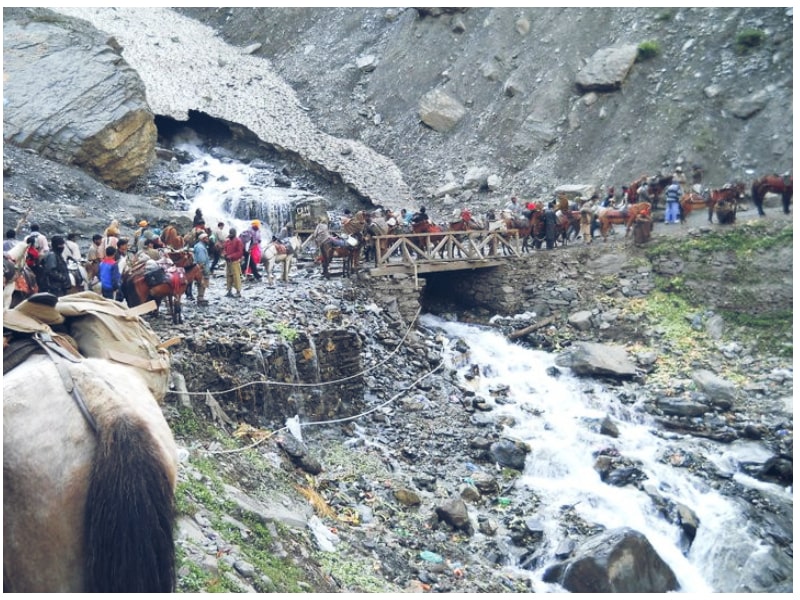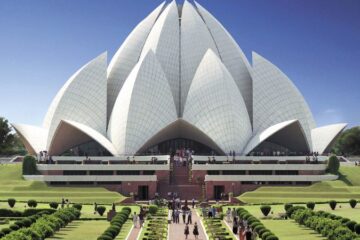
Table of Contents
About Shri Amarnath Cave Temple
- Shri Amarnath Cave Temple is one of the famous Hindu Temples of Lord Shiva.
- The mandir is shaped like a cave which is 19 meters long, 16 meters wide and 11 meters high.
- Inside the cave, there is the Shiva Lingam(phallus-shaped ice formation), which Hindus around the world consider the most sacred symbol.
- Most of the time in the year it is covered with the snow leaving in summer. That’s the reason Amarnath Yatra only starts in summer in June month and ends in August.
- And another perfect reason is according to Hindus religious Shravan Mas which belongs to Lord Shiva starts in July. So it is the perfect reason and time for Amarnath yatra.
- This mandir is considered the sanctified shrine of India.
- Amarnath Dham is one of 51 Shaktipith temples throughout South Asia that perpetuate the whereabouts of the fallen body parts of the Hindu deity Sati.
- Shri Amarnath Cave Temple is one of the holiest spiritual destinations in India, despite having to make a difficult trek to reach it.
Amarnath Mandir Location
- Amarnath Mandir Location is Jammu & Kashmir.
It was constructed 5000 years ago and is an important part of ancient Hindu mythology. - The temple is at the peak of 12,756 feet from sea level from Srinagar, the summer capital of Jammu and Kashmir, and can be reached via the town of Pahalgam.
- Surrounded by snow-capped mountains on all sides, this mandir occupies an important position in the Hindu religious system and is considered to be one of the most sacred places of Bholenath.
- Due to its ice content, the cave is a holy place for Hindu pilgrims.
- Shri Amarnath Cave Temple is a famous Hindu sacred site. It contains Shiva Lingam, which is formed by melting ice from the top of the cave to the floor.
Story of Amarnath Temple
- Story of Amarnath Temple is, “Once Maa Parvati asked her husband Shiva that why he wears Munda mala”. He replied that every time you are born I wear a new head and add it to my mala. Then Parvati asked that why he is immortal and she dies every time. He beautifully replied that it all happens due to Amar Katha. So she said to them that she wants
to listen to Amarkatha. But Shiva didn’t tell her and they ignore their words. Maa Parvati requested them several times but he ignored their request all the time. Finally, he agreed one day and said that he will tell her story. But he also wants to confirm that no one could hear this story. So they came here and tell them the story inside the den. While listening to the story in middle, Maa Parvati got to sleep. Bholenath didn’t see her and they were continuously telling the story. When the story ends he saw that Parvati is sleeping and a pair of pigeons were there. Now Shiva came to know that the pigeons have heard the story. So they got angry at pigeons. The Pigeons Were fall to his feet and said that we are sorry but you can’t kill us because the story was about immortals. And if you kill us the story will go wrong and nobody will believe in it. After listening to this Shiva pardon them and gave him the blessing that they will know as a couple of Lord Shiva and Parvati and the place will be known as Amarnath. That’s the reason it is called Amarnath Mandir and story is known as Amarnath Temple Story.
Who Discovered Amarnath Cave?
Everyone know this famous temple but nobody actually knows, “Who Discovered Amarnath Cave“? People says that Bhrigu the great Sage is said to have been the first to darshan Lingam in the this cave. But after the discovery of the sacred den it referred to related accounts of the den in the Middle Ages, people forgot the cave and the magic that is created in the form of ice over the years until one day the Lingam was guarded by Buta Malik who rediscovered it in the 15th century. As soon as people heard about Lingam, it became Lord Shiva’s abode for believers and the site of an annual pilgrimage by people to lakes in July and August during the Hindu holy month of Savan. Amarnath Shivlingam is one of the Holy Trinity of Shiva, the living God, making pilgrimages through rough terrain to attain eternal happiness.

Amarnath Jyotirlinga
Shri Amarnath Cave Temple is famous for Amarnath Jyotirlinga which naturally formed the Shivlinga in the form of melting ice on the roof and floor of the den. Shiva Lingam – the main attraction of Yatra Stalagmit is formed due to the precipitation and freezing of water droplets of the den, which grow vertically until they reach the roof of the cave from the floor. The eldest is considered the Shivlingam, and the other two little ones are considered Mata Parvati and their son Lord Ganesha. In addition to the main lingam, three other formations representing the lesser lingams are worshiped as Lord Ganesha and Goddess Parvati and Bhairava. It is considered an important part of the Hindu religious system and is considered one of Lord Shiva’s sacred shrines. Thousands of devotees from all over the country come here to see this. They believe that watching this naturally formed shiv linga is like watching Mahadev in real. And they also believe that by watching Amarnath Jyotirlinga and visiting this mandir we get freedom from all our sin.
The Sacred Cave of Amarnath
The Sacred cave of Amarnath among the most sacred and spiritual destinations in India and must undergo an arduous walk to reach them. Devotees visit the shrine in large numbers during the pilgrimage from June to August, known as “Amarnath Yatra,” which begins in Chandanwari. Amarnath’s Shiva Lingam, a phallus-shaped formation of ice, is considered a sacred symbol by Hindus around the world.

Amarnath Yatra
- Amarnath Yatra is one of the four pilgrimages in India and has throngs of believers who travel to Shri Amarnath holy shrine every year through southern Kashmir and the Himalayas. The Amarnath Dham in the Indian state of Kashmir dedicated to bholenath is said to be more than 5,000 years old and represent an important part of ancient Hindu mythology. The mandir is one of the holiest pilgrimage sites in Hinduism, is only open to pilgrims for a short time in summer.
- Every year thousands of Hindu worshippers make a pilgrimage to the 3,888 m altitude to see the ice stalagmites that form at this altitude. Every year in July and August, the government of Jammu and Kashmir state organizes an annual yatra to the sacred Amarnath Cave at 14,000 feet above sea level. During these months, a popular annual Hindu pilgrimage of 600,000 or more pilgrims to Amarnath’s high-glacier cave shrine and the Himalayan ice stalagmite Shiv Linga is known as Amarnath Yatra.
Amarnath Mandir Route
- Shri Amarnath Cave Temple Yatra starts from two villages Pahalgam and Baltal. From Baltal Shri Amarnath Dham is approx 15 Km. away and from Pahalgam, it is approx 41 km. But trek from Baltal is a little bit hard so most people choose Pahalgam for trekking. These Pahalgam treks usually take 3-5 days to reach there. And another perfect reason is trekking through Pahalgam is that you would see the natural beauty of that place.
- Start with a mountain hike from Nunwan and Chandanwari Base Camps in Pahalgam and reach the den after spending the night at Sheshnag Lake and Panchtarni Camps. It is located at the top of the Anantnag area at about 13,000 feet above sea level. The Anantnag area is famous for the Amarnathji Cave, located on Mount Amarnath, which is about 5486 meters above sea level. Whatever the legends and history of Amarnath discovery, today it is a very important pilgrimage center, and although the route is as difficult to navigate as it is to capture, every year thousands of devotees come to pay tribute to Shiva at one of his famous Himalayan mansions.
Devotees of Baba Amarnath
Devotees visit each year Amarnath Dham to catch a pious glimpse of the Lingam of Lord Shiva that is believed to be in form of ice. During the month of Shravan (July – August) at Shri Amarnathji’s holy den shrine flock to receive an image of Lord Shiva in the form of a lingam (a form of ice stalagmites) growing and decreasing with the moon. Sri Amarnath Yatra is valid for a specific period/duration, starts on the announced date, usually on the auspicious day of Skandshastha according to the Hindu calendar, and ends with Sravan Purnima (Raksha Bandhan). Sri Amarnath cave temple is one of the most sacred spiritual sites in India, despite the fact that he had to go through the difficult journey to get to it. Yatras (treks) from the mountains of South Kashmir and the Himalayas to the shrine are also provided during the summer months to pay homage.

Weather of Amarnath Dham
The Weather of Amarnath Dham fluctuates frequently. The temperature remains between 10°c – 32°c during Amarnath Yatra.
| Summers | May to June | 10°c – 27°c |
| Monsoon | July to Sep | 12°c – 30°c |
| Winter | Oct to April | -7°c – 27°c |
Places to visit near Amarnath Temple
Patni Top, Pahalgam, Baltal, Srinagar, Sonmarg and Gulmarg are some places to visit near Amarnath Temple before or after Amarnath Yatra. If you want to explore places in and around Amarnath in Kashmir, these are the places you can’t miss:
Brief Story of Amarnath
The Amarnath Dham is a Hindu shrine in Jammu and Kashmir, India. Due to the constant demands of Maa Parvati, Lord Shiva chose a remote place where no one would listen to the story she tells in the secret story and the most suitable place for him was Amarnath Dham. At the top of the cave, water trickled down and solidified into a form of ice that formed a solid base and took the form of Shiva Lingam (Lingam), believing that the ice on Purnima would take on its full form.
How to reach Amarnath Cave?
By Air
- If you are going by air, then you have to fly to Srinagar Airport, which is approximately 90 km. far from Pahalgam and 105 km. from Baltal. From Srinagar Airport you have to take a bus or taxi to reach Pahalgam or Baltal.
By Train
- If you are going by train, you have to go to Jammu Station which is 178 km. far from Shri Amarnath Cave Temple. After reaching there you can take a bus or taxi for Pahalgam or Baltal.
By Road
- If you are going by road, then you have to arrive at Jammu and then you can take a bus or taxi for Pahalgam or Baltal.
Frequently Asked Questions (FAQs)
1. What is Amarnath Mandir?
Ans. The Amarnath Mandir, situated in the Indian union territory of Jammu and Kashmir, is a revered Hindu temple dedicated to Lord Shiva. It is nestled in the picturesque Lidder Valley, at an altitude of approximately 3,888 meters above sea level. The temple enshrines an ice stalagmite, considered a manifestation of Lord Shiva himself, which waxes and wanes with the phases of the moon during the summer months.
2. What is the significance of Amarnath Mandir?
Ans. The significance of Amarnath Mandir lies in its association with Hindu mythology and spirituality. According to legend, it is believed to be the place where Lord Shiva revealed the secret of immortality to his consort, Goddess Parvati. The annual pilgrimage to the cave shrine, known as the Amarnath Yatra, holds immense religious importance for Hindus, symbolizing devotion and penance.
3. How can one reach Amarnath Mandir?
Ans. Reaching Amarnath Mandir involves a rigorous yet spiritually enriching journey. The traditional route begins from Pahalgam or Baltal, both serving as base camps for the pilgrimage. Pilgrims undertake a challenging trek through rugged terrain, crossing icy streams and steep slopes, to reach the holy cave. Helicopter services are also available for those seeking a quicker but equally awe-inspiring journey.
4. When does the Amarnath Yatra take place?
Ans. The annual Amarnath Yatra commences during the Hindu month of Shravan (usually July to August), coinciding with the auspicious day of Guru Purnima. It spans over several weeks, with devotees braving harsh weather conditions to undertake the pilgrimage. The yatra culminates on Raksha Bandhan, marking the peak of spiritual fervor and celebration.
5. What are the safety measures for the Amarnath Yatra?
Ans. Given the challenging terrain and harsh climate, ensuring the safety of pilgrims during the Amarnath Yatra is paramount. The government, in collaboration with local authorities, implements various safety measures, including medical camps, accommodation facilities, and security arrangements along the pilgrimage route. Pilgrims are advised to undergo a medical check-up and obtain necessary permits before embarking on the journey.
6. What are the accommodation options during the Amarnath Yatra?
Ans. During the Amarnath Yatra, several accommodation options are available to cater to the diverse needs of pilgrims. These include tented accommodations, government guesthouses, private lodges, and temporary shelters set up by voluntary organizations along the pilgrimage route. Advance booking is recommended to secure suitable accommodation amidst the high demand during the yatra season.
7. Are there any dietary restrictions during the pilgrimage?
Ans. As a part of their spiritual journey, pilgrims observe certain dietary restrictions during the Amarnath Yatra. Vegetarian food is predominantly available along the pilgrimage route, with emphasis on light, nutritious meals to sustain energy levels during the arduous trek. It is advisable to carry packaged snacks and sufficient water to stay hydrated throughout the journey.
8. What rituals are performed at Amarnath Mandir?
Ans. Upon reaching the holy cave of Amarnath Mandir, pilgrims partake in various rituals to seek the blessings of Lord Shiva. The darshan (sight) of the ice lingam, believed to symbolize the divine presence of Lord Shiva, is the highlight of the pilgrimage. Devotees offer prayers, perform aarti (ritual of worship), and seek forgiveness for their sins, immersing themselves in the spiritual ambiance of the sacred shrine.
9. What is the significance of the Amarnath Yatra for devotees?
Ans. For devotees undertaking the Amarnath Yatra, the pilgrimage holds profound spiritual significance. It is not merely a physical journey but a soul-stirring experience that fosters introspection, devotion, and a deeper connection with the divine. The arduous trek through the Himalayas serves as a metaphor for life’s challenges, with each step symbolizing perseverance and faith in the ultimate pursuit of salvation.
10. How does the Amarnath Yatra contribute to cultural heritage?
Ans. Beyond its religious connotations, the Amarnath Yatra plays a pivotal role in preserving and promoting India’s cultural heritage. It serves as a testament to the enduring faith of millions of Hindus and stands as a symbol of unity amidst diversity. The pilgrimage fosters communal harmony, as people from diverse backgrounds come together to partake in a shared spiritual journey, transcending barriers of caste, creed, and nationality.


